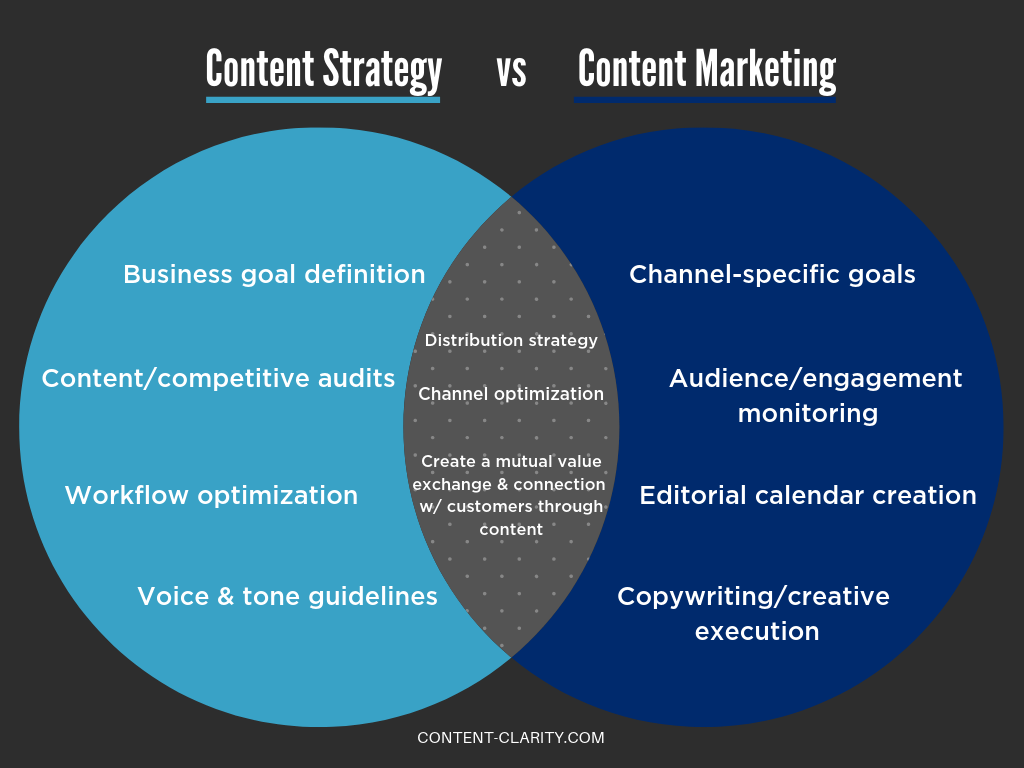
Often times, people assume content marketing and content strategy are the same thing. But that’s a fallacy, and understanding how these concepts are different and where they intersect is key to finding the right skill sets and planning content initiatives for your organization.
So, when would you need a content strategy vs. content marketing program? Let’s take a look at how these concepts differ and relate:
What’s the difference between content strategy and content marketing?
Content Strategy
Before crafting content that gets your brand noticed, you need to have a solid content strategy in place. In fact, 98% of senior marketers believe having a content strategy is important to achieving success.
It acts as an overarching plan that covers the who, what, where, and why of your company’s content — with emphasis on the why. Think about your marketing goals and why you are making content in the first place. This should come before any creative brainstorming or execution and provide a foundation.
Here are some questions you might consider:
- Who is our target audience?
- What’s our goal for creating content?
- What’s the competition doing, and how will we differentiate?
- How do we ensure a consistent brand voice and tone?
- What resources, technologies, and workflows do we need to have in place?
- What channels will help us reach our audience? How do we optimize across each?
- How will we measure success?
Although it’s ideal to have a documented content strategy, it can continually evolve based on performance metrics, shifting company goals, and overall market & consumer trends.
It’s true – creating a strategy involves research, analysis, planning, and frankly, time. However, it’s vital to implement a solid strategy before investing in content creation if you want your content to actually move the needle.
Content Marketing
Content marketing should come after you have a content strategy in place. This is where you execute on your strategy by creating valuable, educational, and intriguing content for a specific target audience. While there’s a level of strategy involved in content marketing, content marketing is just one tactic that a content strategy might encompass.
In traditional advertising, a company tells customers why they should buy from them and what makes their business so great. Content marketing, on the other hand, attempts to create a mutual value exchange with customers by providing valuable or entertaining content (or otherwise helping consumers solve their problems) in an effort to boost trust and loyalty.
Content marketing typically centers around an editorial calendar and involves collaboration among writers, creatives, and social media managers who work to ensure content is updated regularly and is driving the goals outlined in the strategy. A typical brainstorm would involve a different set of questions:
- What channels or mediums are performing the best for us?
- Are there any trending topics or events our brand could tap into?
- What events or product launches are on the horizon that we’ll want to promote?
- Should we run a campaign or sweepstakes to help us increase our reach?
- What keywords should we be incorporating into our blog posts?
- How can we make our content more shareable?
Beyond copy, content marketing can involve the production of many types of content. Among them:
- Blog posts
- Articles
- Videos
- Infographics
- EBooks
- Webinars
- Whitepapers
- Infoguides
- Even memes!
By providing useful content, brands are able to build a connection with their audience and show they care for their customers’ needs. When customers feel understood by a business, they become loyal to the company and are more likely to purchase its products and services.
A real-world example of content marketing

(Image from One More Thing blog)
Bed Bath & Beyond’s blog, One More Thing, is a great example of content marketing done well. The blog features easy-to-read posts about lifestyle topics in various formats ranging from interviews and educational tips to recipes.
Some of the articles answer common questions their readers have and provide helpful advice, such as this article about how to craft with little storage space.
Although Bed, Bath & Beyond isn’t mentioned explicitly in the posts (on purpose), you’ll find a list of featured products as well as suggestions for stories you might like. For example, at the bottom of a post about how to make a roasted veggie sandwich, readers are greeted with these options:

(Image from One More Thing blog)
These choices give the reader the power to stay on the blog or shop on Bed Bath & Beyond’s website. This is a smart content marketing strategy considering the average person consumes 11.4 pieces of content before making a purchasing decision. When it comes time to purchase, Bed Bath & Beyond and its products will likely be top-of-mind.
How are content strategy and content marketing related?

Content strategy and content marketing often go hand-in-hand. It takes a mapped-out content strategy to produce impactful results in your content marketing campaigns.
Companies often make the mistake of rushing through the content strategy or skipping it altogether because it can be tedious – and of course, it’s more exciting to plan out the creative part of your content marketing campaigns. But there’s no use in investing time, money, and effort into your brand’s content marketing if you can’t articulate why you’re doing it or how you’ll evaluate your success.
A content marketing strategy helps you know which keywords to use, how to implement killer CTAs, and when and where to talk about your products. Developing a content strategy will help you nail down the purpose for your content marketing campaigns (and other initiatives), whether it’s to drive traffic, sales, brand awareness, or something else. With a thorough content marketing strategy, your content marketing campaigns will reach your target audience and convert them into loyal customers.
Does your business have a content strategy in place? Let us know your company’s process for producing quality content in the comments!
